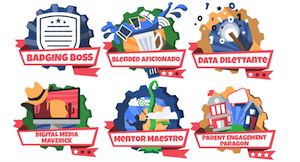
Have you ever been frustrated by the myriad of technology systems you use to manage your school day? Have you spent valuable time entering the same data into multiple systems? Most educators have been a victim of dual data entry, which ruthlessly steals your precious time. Other victims find themselves attempting to make key decisions based on stale data. Using stale data is like trying to drive to a new destination and having your GPS ask you to turn five minutes after you have passed the turn.
So how do we solve these problems? As districts increase their use of technology-based systems, the need for secure interoperability between these systems has become critical.
Data interoperability to the rescue!
Data interoperability is the seamless, controlled, and secure exchange of data between your technology systems. But how do we make it a reality?By choosing systems that align with interoperability standards.
The Ed-Fi Alliance, funded by the Michael & Susan Dell Foundation, is a group of educators, technologists, and thought leaders shaping the future of education technology through the Ed-Fi data standard. Another example is the IMS Global OneRoster 1.1 standard, designed for securely sharing class rosters and related data between student information systems (SIS) and any other systems, like learning management systems (LMS).
Standards for data interoperability are a huge step forward—but if you’re like me, you’re also concerned about the bad guys stealing that data.
Interoperability and security
If there is a breach in one district technology system, could data interoperability put all your connected systems at risk?Thankfully, no! The architecture of data interoperability is like a one-way valve, preventing a bad actor from jumping from one system to another. Under the hood, the data interoperability standards require sending data over an encrypted and secured connection, often using an application programming interface (API). The API’s secured connection requires authentication, authorization, and encryption.
Authentication is a fancy way of saying the system must log in—and in the API world, this requires an API key (think of this as a user) and secret (long, complex password). Authorization is the process of granting permission within the technology system and ensures the API can only access the data it requires. Encryption keeps the data protected against eavesdropping as it moves between your technology systems.
Steps for your district
To advance data interoperability in your district, express urgency to your school board to pursue edtech purchases that support data interoperability standards. You can also join the community and connect with people who are committed to improving data interoperability in K-12 by signing the Project Unicorn pledge or joining the Ed-Fi Alliance.Interoperability for the win
Not only does interoperability reduce dual entry and ensure information stays up to date, but it keeps your data secure too. Is your district using systems that align with interoperability standards? If not, there’s never been a better time to start.Follow-up resource: The Golden Rule of Interoperability
The golden rule of interoperability is simple: treat others’ private data the way you’d want yours to be treated. Learn more here!WHAT'S NEXT FOR YOUR EDTECH? The right combo of tools & support retains staff and serves students better. We'd love to help. Visit skyward.com/get-started to learn more.

|
Mike Bianco Director of Information & Data Security |




